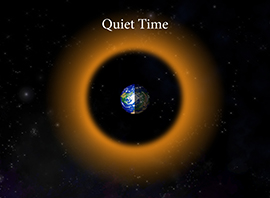19 May 2016
Van Allen Probes reveal long-term behavior of Earth’s ring current
Posted by Nanci Bompey
By Geoffrey Brown and Karen C. Fox

During periods when there are no geomagnetic storms impacting the area around Earth, high-energy protons (with energy of hundreds of thousands of electronvolts, or keV; shown here in orange) carry a substantial electrical current that encircles the planet (also known as “the ring current”).
Credit: Johns Hopkins APL
New findings based on a year’s worth of observations from NASA’s Van Allen Probes have revealed that the ring current — an electrical current carried by energetic ions that encircles our planet — behaves in a much different way than previously understood.
The ring current has long been thought to wax and wane over time, but the new observations show that this is true of only some of the particles, while other particles are present consistently. Using data gathered by the Radiation Belt Storm Probes Ion Composition Experiment, or RBSPICE, on one of the Van Allen Probes, researchers have determined that the high-energy protons in the ring current change in a completely different way from the current’s low-energy protons. Such information can help adjust our understanding and models of the ring current — which is a key part of the space environment around Earth that can affect our satellites.
The findings were published in Geophysical Research Letters, a journal of the American Geophysical Union.
“We study the ring current because, for one thing, it drives a global system of electrical currents both in space and on Earth’s surface, which during intense geomagnetic storms can cause severe damages to our technological systems,” said lead author of the study Matina Gkioulidou, a space physicist at the Johns Hopkins University Applied Physics Laboratory in Laurel, Maryland. “It also modifies the magnetic field in the near-Earth space, which in turn controls the motion of the radiation belt particles that surround our planet. That means that understanding the dynamics of the ring current really matters in helping us understand how radiation belts evolve as well.”

During periods when geomagnetic storms affect Earth, new low-energy protons (with energy of tens of thousands of electronvolts, or keV; shown here in magenta) enter the near-Earth region, enhancing the preexisting ring current (orange).
Credit: Johns Hopkins APL
The ring current lies at a distance of approximately 6,200 to 37,000 miles (10,000 to 60,000 km) from Earth. The ring current was hypothesized in the early 20th century to explain observed global decreases in the Earth’s surface magnetic field, which can be measured by ground magnetometers. Such changes of the ground magnetic field are described by what’s called the Sym-H index.
“Previously, the state of the ring current had been inferred from the variations of the Sym-H index, but as it turns out, those variations represent the dynamics of only the low-energy protons,” said Gkioulidou. “When we looked at the high-energy proton data from the RBSPICE instrument, however, we saw that they were behaving in a very different way, and the two populations told very different stories about the ring current.”
The Van Allen Probes, launched in 2012, offer scientists the first chance in recent history to continuously monitor the ring current with instruments that can observe ions with an extremely wide range of energies. The RBSPICE instrument has captured detailed data of all types of these energetic ions for several years. “We needed to have an instrument that measures the broad energy range of the particles that carry the ring current, within the ring current itself, for a long period of time,” Gkioulidou said. A period of one year from one of the probes was used for the team’s research.
“After looking at one year of continuous ion data it became clear to us that there is a substantial, persistent ring current around the Earth even during non-storm times, which is carried by high-energy protons. During geomagnetic storms, the enhancement of the ring current is due to new, low-energy protons entering the near-Earth region. So trying to predict the storm-time ring current enhancement while ignoring the substantial preexisting current is like trying to describe an elephant after seeing only its feet,” Gkioulidou said.
The Johns Hopkins University Applied Physics Laboratory in Laurel, Maryland, built and operates the Van Allen Probes for NASA’s Science Mission Directorate. RBSPICE is operated by the New Jersey Institute of Technology in Newark, New Jersey. The mission is the second mission in NASA’s Living With a Star program, managed by NASA’s Goddard Space Flight Center in Greenbelt, Maryland.
— Geoffrey Brown is a public affairs officer at Johns Hopkins University Applied Physics Laboratory. Karen Fox is a science writer at NASA’s Goddard Space Flight Center. This post originally appeared as a press release on the JHUAPL and NASA Goddard websites.










 GeoSpace is a blog on Earth and space science, managed by AGU’s Public Information staff. The blog features posts by AGU writers and guest contributors on all sorts of relevant science topics, but with a focus on new research and geo and space sciences-related stories that are currently in the news.
GeoSpace is a blog on Earth and space science, managed by AGU’s Public Information staff. The blog features posts by AGU writers and guest contributors on all sorts of relevant science topics, but with a focus on new research and geo and space sciences-related stories that are currently in the news.